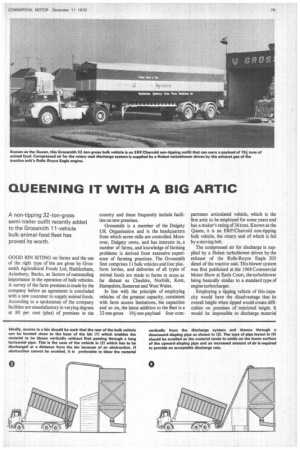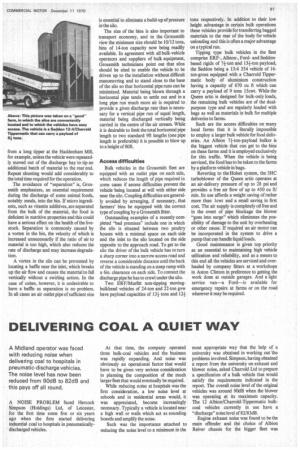QUEENING IT WITH A BIG ARTIC
Page 85

Page 87

If you've noticed an error in this article please click here to report it so we can fix it.
A non-tipping 32-ton-gross semi-trailer outfit recently added to the Grossmith 1 1-vehicle bulk-animal-food fleet has proved its worth.
GOOD BIN SITING on farms and the use of the right type of bin are given by Grossmith Agricultural Foods Ltd, Haddenham, Aylesbury, Bucks, as factors of outstanding importance in the operation of bulk vehicles. A survey of the farm premises is made by the company before an agreement is concluded with a new customer to supply animal foods. According to a spokesman of the company facilities are unsatisfactory in varying degrees at 80 per cent (plus) of premises in the country and these frequently include facilities on new premises.
Grossmith is a member of the Dalgety UK Organisation and is the headquarters from which seven mills are controlled. Moreover, Dalgety owns, and has interests in, a number of farms, and knowledge of fanning problems is derived from extensive experience of farming practices. The Grossmith fleet comprises 11 bulk vehicles and four platform lorries, and deliveries of all types of animal foods are made to farms in areas as far distant as Cheshire, Norfolk, Kent, Hampshire, Somerset and West Wales.
In line with the principle of employing vehicles of the greatest capacity, consistent with farm access limitations, bin capacities and so on, the latest addition to the fleet is a 32-ton-gross 194--ton-payload four-corn
partment articulated vehicle, which is the first artic to be employed for some years and has a maker's rating of 36 tons. Known as the Queen, it is an ERF/Charrold non-tipping bulk vehicle, the rotary seal of which is fed by a moving belt.
The compressed air for discharge is supplied by a Holset turboblower driven by the exhaust of the Rolls-Royce Eagle 205 diesel of the tractive unit. This blower system was first publicised at the 1968 Commercial Motor Show at Earls Court, the turboblower being basically similar to a standard type of engine turbocharger.
Employing a tipping vehicle of this capacity would have the disadvantage that its overall height when tipped would create difficulties on premises of restricted height. It would be impossible to discharge material from a long tipper at the Haddenharn Mill, for example, unless the vehicle were repeatedly moved out of the discharge bay to tip an additional batch of material to the rear end. Repeat shunting would add considerably to the total time required for the operation.
The avoidance of "separation" is, Grossmith emphasizes, an essential requirement during the discharge of some animal foods, notably meals, into the bin. If micro ingredients, such as vitamin additives, are separated from the bulk of the material, the food is deficient in nutritive properties and this could have a serious effect on the health of the livestock. Separation is commonly caused by a vortex in the bin, the velocity of which is increased unnecessarily if the ratio of air to material is too high, which also reduces the rate of discharge and may increase degradation.
A vortex in the silo can be prevented by locating a baffle near the inlet, which breaks up the air flow and causes the material to fall vertically without a swirling action. In the case of cubes, however, it is undesirable to have a baffle as separation is no problem. In all cases an air outlet pipe of sufficient size is essential to eliminate a build-up of pressure in the silo.
The size of the bins is also important to transport economy, and in the Grossmith view the minimum size should be 10/12 tons, bins of 14-ton capacity now being readily available. In agreement with all bulk-vehicle operators and suppliers of bulk equipment, Grossmith technicians point out that silos should be sited to enable the vehicle to be driven up to the installation without difficult manoeuvring and to stand close to the base of the silo so that horizontal pipe runs can be minimized. Material being blown through a horizontal pipe tends to settle out and in a long pipe run much more air is required to provide a given discharge rate than is necessary for a vertical pipe run of equal length, material being discharged vertically being carried in the centre of the air stream. While it is desirable to limit the total horizontal pipe length to two standard 9ft lengths (one pipe length is preferable) it is possible to blow up to a height of 80ft.
Access difficulties Bulk vehicles in the Grossmith fleet are equipped with an outlet pipe on each side, which reduces the length of pipe required in some cases if access difficulties prevent the vehicle being located at will with either side near the silo. Coupling difficulties are generally avoided by arranging, if necessary, that farmers' bins be equipped with the correct type of coupling by a Grossmith fitter.
Outstanding examples of a recently completed "bad premises" include one in which the silo is situated between two poultry houses with a minimal space on each side and the inlet to the silo located on the side opposite to the approach road. To get to the silo the driver of the bulk vehicle has to turn a sharp corner into a narrow access road and reverse a considerable distance until the back of the vehicle is standing on a steep ramp with a 6in, clearance on each side. To connect the discharge pipe he has to crawl under the silo.
Two ERF/Murfitt non-tipping movingbulkhead vehicles of 24-ton and 22-ton gvw have payload capacities of 134tons and 124 tons respectively. In addition to their low height advantage in certain bulk operations these vehicles provide for transferring bagged materials to the rear of the body for vehicle unloading and this is often a major advantage on a typical run.
Tipping type bulk vehicles in the fleet comprise ERF-, Albion-, Fordand Seddonbased rigids of 74.-ton and 13-i-ton payload, the Seddon being a 13:4 354 vehicle of 16ton-gross equipped with a Charrold Tippermatic body of aluminium construction having a capacity of 670 cu ft which can carry a payload of 9 tons 15cwt. While the Queen artic is designed for bulk-only loads, the remaining bulk vehicles are of the dualpurpose type and are regularly loaded with bags as well as materials in bulk for multiple deliveries to farms.
Such are the access difficulties on many local farms that it is literally impossible to employ a larger bulk vehicle for food deliveries. An Albion 74.-ton-payload buiker is the biggest vehicle that can get to the bins on these farms and it is employed exclusively for this traffic. When the vehicle is being serviced, the food has to be taken to the farms by a platform vehicle in bags.
Reverting to the Holset system, the 31{C turboblower of the Queen artic operates at an air-delivery pressure of up to 28 psi and provides a free air flow of up to 450 cu ft/ min. Its use affords a weight saving of rather more than 1 cvit and a small saving in first cost. The air supply is completely oil free and in the event of pipe blockage the blower "goes into surge" which eliminates the possibility of damage to the unit by overheating or other cause. If required an air motor can be incorporated in the system to drive a pump that can handle liquid loads.
Good maintenance is given top priority as an essential to maintaining high vehicle utilization and reliability, and as a means to this end all the vehicles are serviced and overhauled by company fitters at a workshops in Aston Clinton in preference to getting the work done at outside garages. And a light service van—a Ford—is available for emergency repairs at farms or on the road wherever it may be required.






























































































































































